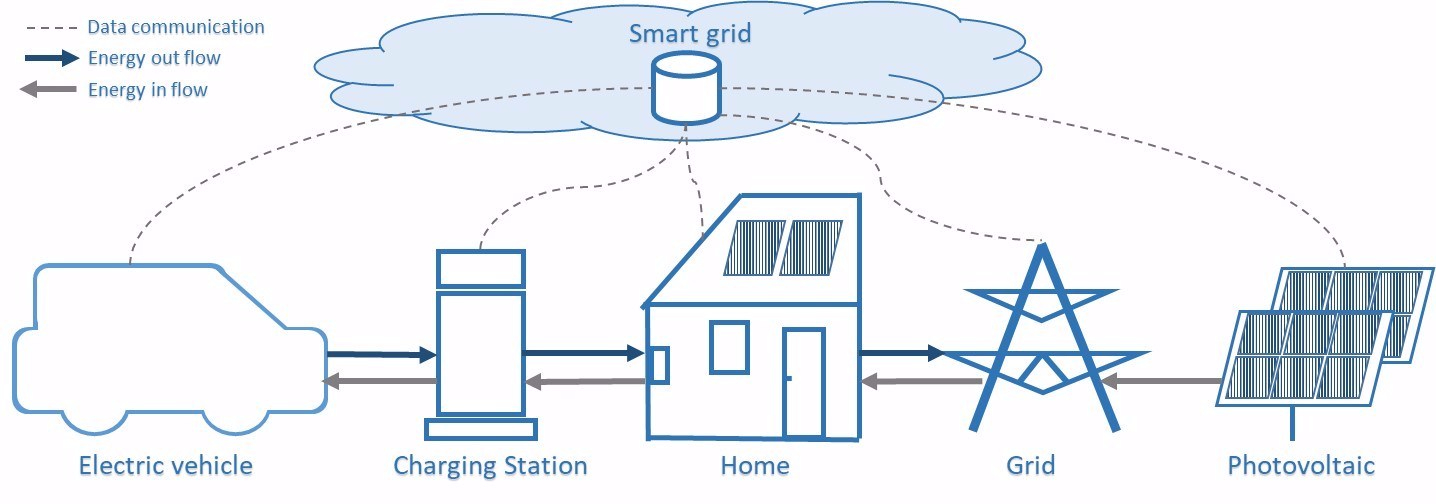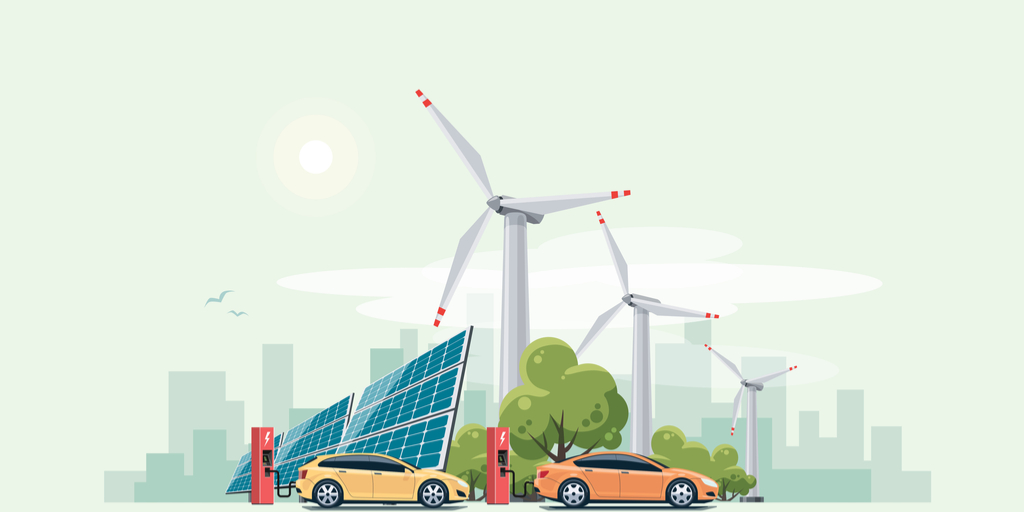Would you use your car battery to store electricity for your home or for your energy provider? This simple question summarises the perception of vehicle-to-grid (V2G) for EV drivers. This concept is, of course, more complicated than it seems and raises a lot of questions; How does it work? Is it practical? What do I get out of it? Does it degrade the life of my battery? The purpose of this article is to answer these questions and to analyse the challenges and success factors.
What is the purpose of V2G?
To understand the purpose of vehicle-to-grid, we have to understand the challenges that the energy market is currently facing with growing production of intermittent type of energies such as photovoltaic and wind turbines. As these renewable energies do have an unforeseeable production of energy due to unpredictable weather conditions (wind, sun, temperature), utilities have to stabilise the lake or surplus of electricity on the market. The idea is to store the excess of energy and use the capacity of these batteries to stabilise the grid (electricity network). Electric vehicles or let say “batteries on wheels” with 20 to 100 kWh storage capacity could potentially become an interesting alternative to accommodate the electricity grid. Especially, if we consider that EV’s are stationary for more than 90% of the time.
How does it work?
Vehicle2grid is a solution in which an electric vehicle is connected to an energy grid and share electricity depending on market demand. The charging station has the role to manage bi-directional electricity flows. All these systems are interconnected and included in a smart grid solution.

2 terms are frequently used to describe the structure of V2G:
- Smart Grid: This is a generic term to explain the intelligence components to manage the production and demand of electricity over multiple devices (e.g. Smart Meters).
- Load Balancing: This term describes the distribution of electricity workloads across the car battery and the grid.
Basically, when the production of solar or wind energy will be at its peak and the demand at its lowest, the smart grid would feed the car battery and use this energy when needed.
What are consumer benefits?
At first glance, the whole concept seems to benefit more energy companies than EV drivers. However, some costs and security advantages have to be mentioned. Especially, if it is used at home in combination with a photovoltaic installation.
- Financial benefits with the possibility to reduce electricity costs by storing electricity obtained at lower prices (off-peak times), for a later usage when the demand and cost are higher (Peak times).
- Lower kWh price on public Charging Networks when used on important parking facilities as we can see in this Nissan Italian experiment.
- Security in a home usage (vehicle-to-home) context, the car battery could be used as redundancy or to avoid availability losses on the grid.
What are the V2G challenges?
Vehicle-to-Grid is a complex solution which has to face multiple service and market challenges.
1. Practicability “Ease of use”
Such a service could require the management of multiple parameters. What is the battery level that you would be ready to share? When do you need the full capacity of your battery back? An easy way to solve this challenge would be to set limits and get never lower than 70 or 80% of your battery levels. In other words, the driver shall be able to park and get away with sufficient energy without constant configuration. I would recommend a minimum setup with the battery threshold that you are ready to allocate. Any further configuration based on timing or amount of authorised cycles would be too complex to manage. The objective is to use your car without further worries.
2. Battery deterioration (EV value loss)
Frequent charging cycles (charge and discharge) can harm your car batteries. It does mean that your EV would lose capacity. However, if the battery is used in certain conditions (e.g. with a threshold) it could even increase the life of the battery according to study from the University of Warwick. Nevertheless, any user of a smartphone or laptop would seriously doubt such a study. We should rather care about the amount of charging/discharging cycles per session. Car batteries are also aimed to resist fare more cycles than needed.
3. Compliant electric vehicle for V2G
EV’s has to be compatible with multi-directional charging in a V2G environment. It means that these cars have to be equipped with a compatible inverter which isn’t the case for all car models. Cars such as the Nissan Leaf or other Asian brands (Mitsubishi, Kia, …) with CHAdeMO connection do already fulfil these conditions. Secondly, an EV has to be furnished with a substantial battery size to support a loss of capacity after a V2G charging session. For example, a loss of 20 to 30% capacity when you have a maximum driving range of 150 km could be critical.
4. Attractive and smart kWh pricing
The potential deterioration of a car battery and the fact that you may not have a full charge at the reception of your EV must be compensated.
- The first principle is that the kWh delivered on top of your initial charging level must be significantly cheaper than a standard Public charging session.
- The second principle is the uncomplicated pricing structure. It should be logical to offer financial compensation (negative billing) when the level of your battery is lower than when you initially brought
5. Smart system costs for utilities
Vehicle2grid solution with Smart grid components and applications for drivers is expensive. Return on invest could become challenging for utilities if the service is not widely used. We would, therefore, need millions of EV drivers to make it worth.
6. Competition with storage battery (EES)
The cost of Lithium batteries could decrease by up to 50% in the next 5 years. We can, therefore, expect that important EES storage sites and homes could be equipped with batteries in the future. Consumers would then rather invest in home batteries than using EVs for storage. This is probably the direction that Tesla is taking with the Powerwall product.
7. Too low Market price of electricity
Current kWh market price in central Europe is too low to motivate drivers to make an effort to optimise energy consumptions. The financial benefits of lending an EV battery for storage purposes is too weak against service constraints and potential early amortization of the vehicle.
How can we make it successful?
General success factors of V2G for consumers are in relation to market drivers of electrical energy storage (EES) which is described in this article of March 2017. Next to the challenges that this technology has to overcome, here are four main factors to make it successful:
- Size of batteries: EV batteries have to become more consequent to absorb a temporary loss of capacity or slow degradation (e.g. above 80 kWh)
- Ease of use: This service has to be straightforward and easy to use for drivers. It means no systematic configuration of multiple parameters to ensure a safe journey back home.
- Attractive pricing: An attractive kWh shall be offered to compensate the unpleasantness of EV battery and reduce battery capacity.
- Think Big: We need mighty numbers of EVs (30-40% EV market penetration) on the road to make the investment valuable with massive infrastructure and facilities.
As of today’s, question of V2G success, there are too many hurdles and market changes to expect! I am therefore not yet convinced with this concept but in 10 years with a tense energy market and growing numbers of EVs, I might change my mind. What about you?





Leave a Reply